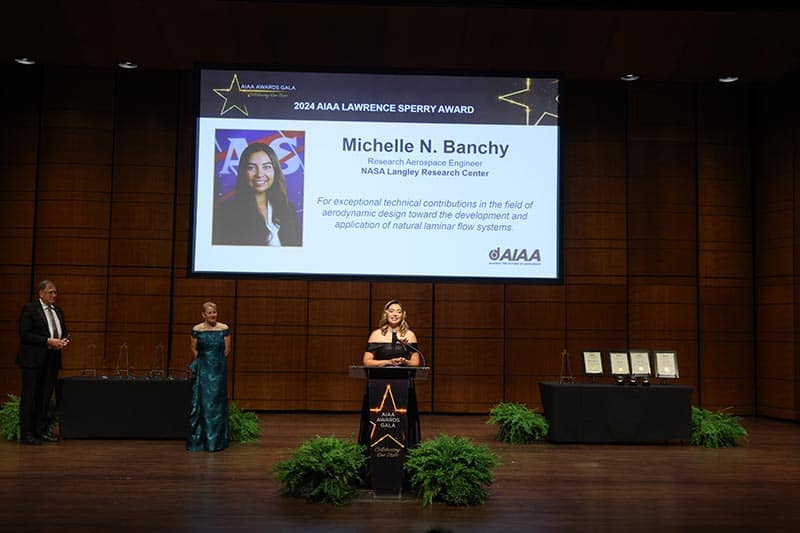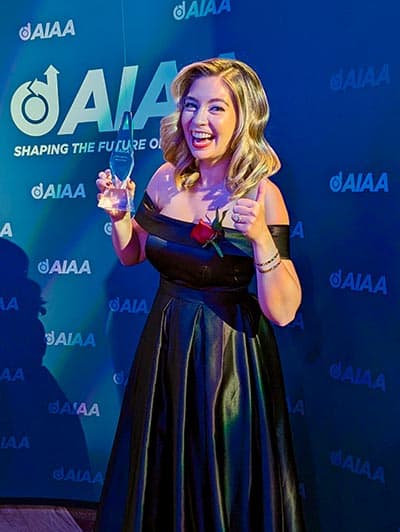
Alumni Profile: Michelle Banchy
Recent AIAA Lawrence Sperry Award winner reflects on her journey through U-M and what led to her recent achievements

Recent AIAA Lawrence Sperry Award winner reflects on her journey through U-M and what led to her recent achievements
From business major to aerospace engineer, Michigan Aerospace alumna Michelle Banchy highlights her journey to becoming the 2024 Lawrence Sperry Award winner from the AIAA. Throughout her time at U-M, Banchy reflects on her career and shares insights on how she got where she is today. Throughout her career, Banchy has celebrated the trial and error process and has used that to excel in the field of aerospace engineering.
Presented by the AIAA, the annual Lawrence Sperry Award honors young professionals under the age of 35 for their notable contributions towards the advancement of aeronautics or astronautics. This year, Michelle Banchy was the recipient of the award, recognizing her outstanding contributions towards the development and application of natural laminar flow systems in the field of aerodynamic design.
“It is truly humbling to be this year’s Sperry Award recipient and be listed alongside the many distinguished previous awardees. I consider myself so fortunate to have a career that I love with rewarding technical projects, brilliant and kind mentors and coworkers, and an amazing support system at home. I am so grateful for all the experiences that have brought me here, including my time at the University of Michigan, which gave me knowledge I use every day in my research at the NASA Langley Research Center,” Banchy explained.
After completing her Masters in Aerospace Engineering from U-M with a focus on gas dynamics, she quickly joined the NASA Pathways Program. It was through this program that she was hired on as a research aerospace engineer in the Configuration Aerodynamics Branch at NASA Langley Research Center.
Following her passion for aviation and aerospace, Banchy reflects on her journey and the path through U-M that led to her recent research and her contributions towards the industry in a recent interview highlighted below.

What inspired you to go into aerospace?
When I was younger, I remember loving airplanes and space. I’ve also always enjoyed puzzles, problem solving, and understanding how things worked. I began college as a Business major, but decided to find a new degree that aligned better with the classes I was enjoying the most. I discovered Aerospace Engineering in the list of available majors at my university and selected it primarily because I knew it involved math and science and it reminded me of my childhood interests. I quickly discovered it was a great fit for me through the coursework and internships I participated in. I’m so grateful to have ended up in a career that I find so interesting and that challenges me daily.
What drew you to U-M Aerospace?
Like many people who are finishing their undergraduate studies, I was torn between continuing onto graduate school or entering the workforce. I ended up selecting a graduate degree primarily because of the reputation of the University of Michigan’s Aerospace program. Being one of the top ranked programs in the country, along with the prestigious history as the oldest aeronautics program, made the decision to attend U-M an easy one. I was also drawn to the big university atmosphere with the fun student events and the large alumni association.
What was your experience like going through the Michigan Aerospace Masters program?
I was only at the University of Michigan for three semesters, so it felt like a whirlwind in some ways. My overall impression was that the classes were high quality and taught by brilliant faculty. I particularly enjoyed that my courses were specialized (my concentration was Gas Dynamics), which enabled me to really dive deeper into areas I enjoyed. I met lifelong friends, the university atmosphere was electric, and it was neat to experience living in the Midwest (although it was admittedly a bit cold for a California native like myself).
What faculty or staff members do you think left a lasting impression?
Most of my interactions with the faculty at the University of Michigan were through classes. The primary impression I had was how knowledgeable everyone was. All my professors had high expectations for their students and were willing to support your effort to achieve those expectations. While I didn’t end up in academia myself, I still found it inspiring to be surrounded by faculty members who were so well respected in their fields. In my career at NASA, I try my best to model their habits and the research approaches that I observed while a student.
Can you tell me a little bit about your research/career?
While at the University of Michigan working towards my Masters degree, I was hired into the Configuration Aerodynamics Branch at NASA Langley Research Center through the NASA Pathways Program. I was able to spend a summer interning in the branch between semesters and then began working full time upon graduation. I’ve been in the branch for 10 years now, working primarily on aerodynamic design. My work has predominantly been computational, utilizing Computational Fluid Dynamics (CFD) and our design code, CDISC, to analyze and alter vehicles to improve performance. My research toward the development of laminar flow technology has also led to my involvement in experimental campaigns, including both wind tunnel and flight testing. I’ve been incredibly fortunate to have had the opportunity to study a range of configurations, flow regimes, and aerodynamic challenges, which has kept things exciting while allowing me to continue learning new things and expanding my skills as an aerodynamicist.
What inspired your research?
I did a rotational internship in my branch when I was a student and found that aerodynamic design aligned best with my strengths and interests. I really enjoy the challenge of understanding complex aerodynamic behavior and the creative aspect of finding ways to redesign and improve a vehicle.
While on the aerodynamic design team, my research has primarily been supported by the NASA Advanced Air Transport Technology Project under the Advanced Air Vehicles Program, which aims to develop technologies and capabilities for new aircraft systems. Laminar flow has been identified as a technology of interest because of its potential to reduce the drag of a vehicle and is currently being considered for application on many next-generation aircraft. One of the primary challenges with laminar flow is maintaining it on large components with high sweep, such as the main wing of a transport vehicle, due to the introduction of crossflow boundary layer instabilities that often lead to premature transition. Addressing this challenge of crossflow instabilities on wings has inspired my research and has led to the technology I co-developed with my colleague Richard Campbell, referred to as Crossflow Attenuated Natural Laminar Flow (CATNLF). We’ve progressed the CATNLF technology from the initial computational studies through the wind tunnel and now to flight. The aim of our research is to find a practical approach to enable the performance benefit associated with laminar flow. The desire to increase the technology readiness level as much as possible is what motivates our team to pursue experimental testing.
What was your journey like leading up to receiving the Lawrence Sperry Award?
When looking back on my journey leading up to the Lawrence Sperry Award, I am filled with gratitude for both the projects and people I’ve had the privilege of working with. I’ve been surrounded by co-workers who have patiently shared their knowledge and expertise with me while encouraging me to grow and try new things. My design team has provided me with a safe space to try new things, where having ideas fail and asking questions is encouraged and expected. The research I’ve been a part of has offered me the opportunity to grow technically, gain leadership experience, and learn new skills needed to work both computational and experimental aspects of aerodynamics.
What advice do you have to other early career researchers or newly graduated students who may be looking towards fellowships?
One of the biggest pieces of advice I have for early career researchers is to try as many different things as possible and to be ok with not liking everything. Aerospace is such a broad field, I found it equally valuable to identify things that didn’t suit me as finding the aspects I love. Reach out to professionals who have the careers that you’re interested in. I’ve found people are excited to share their knowledge and there is a lot to be gained by knowing what parts of their background they’ve found most influential to getting to where you want to be. I also recommend applying for everything that catches your interest and, as much as possible, not let self-doubt eliminate your chances of gaining new experiences. If you don’t let yourself try, you definitely can’t do it!
What have been the highlights of your career so far?
Looking back on my career so far, there are many things that stand out as highlights. Graduating from school will always be one of my major accomplishments. I’m also so proud of the contributions I made toward developing a new approach to enabling large extents of laminar flow on transport wings. That effort has led to the opportunity of leading a major wind tunnel experiment, and I consider it a great honor to have been trusted with that role so early in my career. Leading the progression of my laminar flow research all the way to flight testing has been a huge highlight. I’ve also loved the opportunity to travel internationally, publishing my research and collaborating with individuals worldwide. I still feel so young and early in my career, and I can’t wait to see where the future takes me!